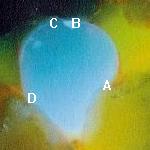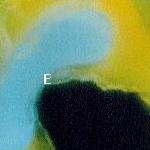The next two images illustrate
- irregular blob shapes and distribution of phases in realistic media,
- the different geometries of wetting and non-wetting phases, and
- the nonwetting phase almost completely occupying a pore body, and the non-wetting and wetting phases sharing the pore body
The photos show two possibilities, obviously many more are possible. |
| |
|

Click image to see more |
Photomicrograph of a single blob occupying one pore body. The non-wetting phase (in blue) occupies the pore body, while the wetting phase (in green) is drawn in along the solid walls of the sand grains. Four places where this behavior is clearly shown are indicated by the letters "A", "B", "C", and "D". The shape of the blob is influenced by the geometry of the pore space. The constriction between "A" and "D" is the main determinant of this shape. More of the photograph can be seen by clicking on the image of the blob. |
| |
|

Click image to see more |
In this case a single blob occupies two pore bodies and a pore throat. (Click on the photo to see the entire image.) Here there is enough of the non-wetting phase to occupy more than one pore body, and the two ends of the blob remain attached to each other. Although larger and more irregular than the single blob, this one can also be seen to be non-wetting. Note that the ends of the blob do not completely fill the pore body. These areas are partly occupied by both the wetting and non-wetting fluids. |